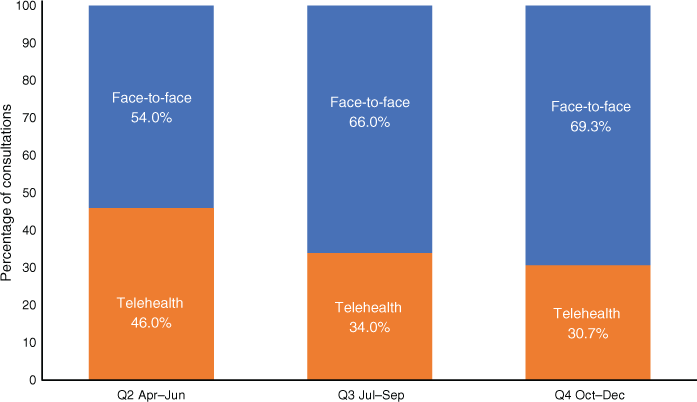Better Access: substantial shift to telehealth for allied mental health services during COVID-19 in Australia
Rebecca Reay A E , Stephen R. Kisely
A E , Stephen R. Kisely  B C D and Jeffrey C. L. Looi
B C D and Jeffrey C. L. Looi  A D
A D
A Academic Unit of Psychiatry and Addiction Medicine, The Australian National University Medical School, Building 4, Level 2, Canberra Hospital, Canberra, ACT, Australia. Email: jeffrey.looi@anu.edu.au
B School of Medicine, The University of Queensland, Princess Alexandra Hospital, Ipswich Road, Woolloongabba, Brisbane, Qld, Australia. Email: s.kisely@uq.edu.au
C Departments of Psychiatry, Community Health and Epidemiology, Dalhousie University, Halifax, Nova Scotia, Canada.
D Consortium of Australian Academic Psychiatrists for Independent Policy Research and Analysis, Canberra, ACT, Australia.
E Corresponding author. Email: rebecca.reay@act.gov.au
Australian Health Review 45(6) 675-682 https://doi.org/10.1071/AH21162
Submitted: 6 May 2021 Accepted: 14 July 2021 Published: 8 November 2021
Journal Compilation © AHHA 2021 Open Access CC BY
Abstract
Objective To quantify the introduction of new, temporary telehealth Medicare Benefits Schedule (MBS) items delivered by allied mental health professionals (AMHPs) through the Better Access initiative during the COVID-19 pandemic in Australia.
Methods MBS-item service data for clinical psychologists, registered psychologists, social workers, and occupational therapists were extracted for existing face-to-face, remote videoconferencing and new, temporary telehealth items for the study period April–December 2020. The total number of services in Australia were compared with the baseline period of 2019. Given the second wave of increased COVID-19 infections and prolonged lockdowns in the state of Victoria, we compared the per capita rate of services for Victoria versus other states and territories.
Results During the study period, there was an overall 11% increase in all allied mental health consultations. Telehealth use was substantial with 37% of all sessions conducted by videoconferencing or telephone consultations. The peak month was April 2020, during the first wave of increasing COVID-19 cases, when 53% of consultations were via telehealth. In terms of Victoria, there was an overall 15% increase in all consultations compared with the same period in 2019.
Conclusions Allied mental health services via MBS-subsidised telehealth items greatly increased during 2020. Telehealth is an effective, flexible option for receiving psychological care which should be made available beyond the pandemic.
What is known about the topic? Little is known about the transition to and delivery of new, temporary Better Access telehealth services by AMHPs during the COVID-19 pandemic.
What does this paper add? This paper provides valuable data on the rapid transition to telehealth by AMHPs to provide levels of psychological care commensurate to 2019. Data extends from April to December 2020 and includes the overall number of services provided for each profession, and the proportion of services delivered via face-to-face and telehealth. We highlight the impact of the new, additional items which temporarily raised the cap on sessions. We also illustrate the substantial use of the scheme by those living in Victoria who experienced greater COVID-19-related hardships.
What are the implications for practitioners? The continuation of Better Access telehealth services by AMHPs has the potential to extend the reach of mental health care beyond the pandemic.
Keywords: e-health, mental health, pandemic, rural and remote health, COVID-19, allied health, Medicare Benefits Schedule, telehealth, Better Access.
Introduction
Early in the pandemic (March–April 2020), community studies of Australians revealed elevated depression and anxiety symptoms resulting from pandemic-induced financial stress, loneliness, and disruptions in the domains of work, leisure and relationships.1 Unprecedented demands on health services were expected due to the acute effects of the COVID-19 pandemic on previously healthy Australians and those with pre-existing mental health conditions.2 The World Health Organization emphasised the urgent need to invest in mental health services to prevent a looming crisis.3 In response, the Minister for Health announced 16 new, temporary telehealth items (videoconference and telephone) for Medicare-subsidised mental health attendances commencing 13 March 2020 and extending until 30 June 2021.4 The initiative aimed to reduce the risk of community transmission of the virus from face-to-face consultations. Videoconferencing was the government-recommended approach for substituting face-to-face consultations, although telephone services could be used when video was not available. Prior to the new telehealth measures, eligible patients could receive a maximum of ten sessions of therapy per calendar year under the Medicare Benefits Schedule (MBS) Better Access initiative.5 From 9 August 2020, the existing face-to-face and telehealth items were expanded to a maximum of 20 individual sessions each year until 30 June 2022.6 Initially the increase was approved only for people subject to public health orders restricting their movements (such as those living in Victoria), although from 9 October 2020 it was extended to all eligible patients on a general practitioner (GP) mental health treatment plan (MHTP). Thus, an additional 24 temporary item numbers were added to the scheme. Under the program, following an assessment with a GP, paediatrician or psychiatrist, patients can be referred for treatment with psychological therapy by clinical psychologists or for focused psychological strategies by registered psychologists, social workers or occupational therapists.
Prior to the COVID-19 measures, psychological sessions by telehealth were only available via videoconference for patients from rural, remote, and very remote regions as determined by the Commonwealth Department of Health, Monash Modified Model regions 4–77 (hereafter referred to as ‘remote videoconference’). Face-to-face items are categorised by location (‘attendance at consulting rooms’ or ‘attendance at a place other than consulting rooms’), type (individual vs group) and length (long sessions vs brief sessions).
A report by the Australian Institute of Health and Welfare investigated MBS-subsidised mental health services (by GPs, psychiatrists, psychologists, and allied health workers) between March 2020 and January 2021.8 Telehealth peaked in April 2020 when half of all services were provided remotely. Another study of allied mental health services reported a 50% reduction in in-person consultations and a corresponding increase in telehealth sessions from April to June 2020.9 However, the study did not include item numbers for face-to-face sessions at a place other than consulting rooms, which is important given many clinicians provide therapy in client’s homes and community settings. Given the previously demonstrated effectiveness of telehealth for mental health care delivery,10 the increased overall and telehealth services provided by GPs and psychiatrists during the first wave of COVID-19 cases,11,12 and the recent increase in caps on the number of allied mental health professional (AMHP) sessions, it is timely to investigate the impact of new allied health telehealth items from April to December 2020.
Specifically, our research examines: 1) whether there has been an overall increase in the provision of MBS items for individual therapy by AMHPs under the Better Access initiative during April–December 2020 (the study period), compared with the 2019 baseline period; 2) the proportion of services that were delivered via telehealth, compared with face-to-face sessions; and 3) a comparison of trends in the state of Victoria, which experienced a second wave of COVID-19 cases, followed by restrictions and lockdown periods.
Methods
MBS-item service data for AMHPs were extracted for the study period (April–December 2020) from the Australian Government Services Australia publicly available website (http://medicarestatistics.humanservices.gov.au/statistics/mbs_item.jsp, accessed 25 February 2021). Specifically, the total number of existing items (i.e. face-to-face items: ‘in consulting rooms’; ‘a place other than consulting rooms’; ‘remote videoconference’) and new COVID-19 telehealth items (videoconference and telephone consultation) were included in the analysis. MBS-item data were extracted for ‘Psychological Therapy Services’ items (clinical psychologists only) and ‘Focussed Psychological Strategies’ (FPS) items, as delivered by eligible, registered psychologists, occupational therapists and social workers for each corresponding monthly period, as described via MBS Online (http://www9.health.gov.au/mbs/search.cfm, accessed 25 February 2021). Month is determined by the date the service was processed by Services Australia, not the date the service was provided. (See Appendix 1 for MBS items used in analysis.)
We excluded MBS items for treatments provided by GPs and psychiatrists to focus on the provision of non-pharmacological, psychological therapies by AMHPs. Group therapy items were also excluded from the analysis due to the likely disruption to group work and the absence of new telehealth items numbers for group therapy.
To assess for changes in allied mental health services during the COVID-19 study period, we compared the total number of sessions with the 2019 baseline period (April–December 2019). To report on clinician uptake of telehealth, we compared the proportion of sessions delivered by videoconference, telephone consultations and remote videoconference with the proportion of face-to-face sessions during the study period. Confidence intervals were not calculated because the numbers are based on census counts of Australia-wide events rather than random samples of some portion of the population.
Results
From April to December 2019, there was a total of 4 522 313 Better Access services provided by AMHPs (see Table 1). Following the arrival of the pandemic, a total of 5 033 077 services were provided from April to December 2020, representing an overall increase of 11%. There was a 29% decrease in total face-to-face consultations during the study period (4 511 436 to 3 195 226) compared with the same period in 2019, as clinicians rapidly transitioned to delivering treatments via telehealth. Thirty-seven percent of all consultations were delivered by telehealth (monthly average). This is a substantial increase from the 2019 baseline period when only 0.2% (10 877/4 522 313) of all consultations were delivered via videoconference (due to strict geographical limits that applied). When AMHPs delivered care via telehealth, they were more likely to use videoconferencing (67%) than telephone consultations (33%). Figure 1 illustrates a month-to-month comparison of the total attendances (face-to-face and telehealth) for each profession, revealing registered psychologists and clinical psychologists are the largest providers, while social workers and occupational therapists provide substantially fewer services under the scheme.
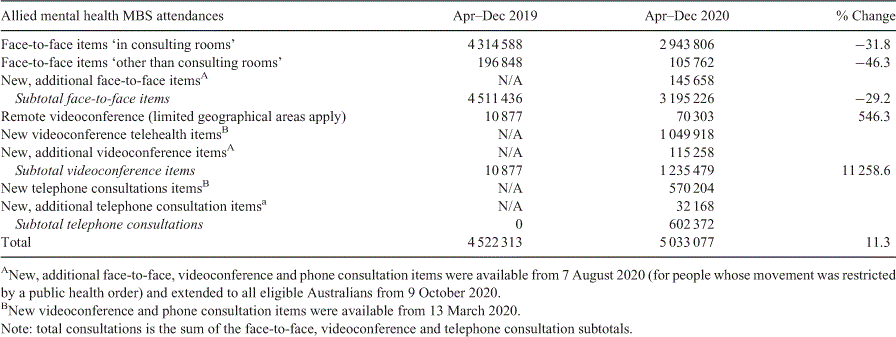
|
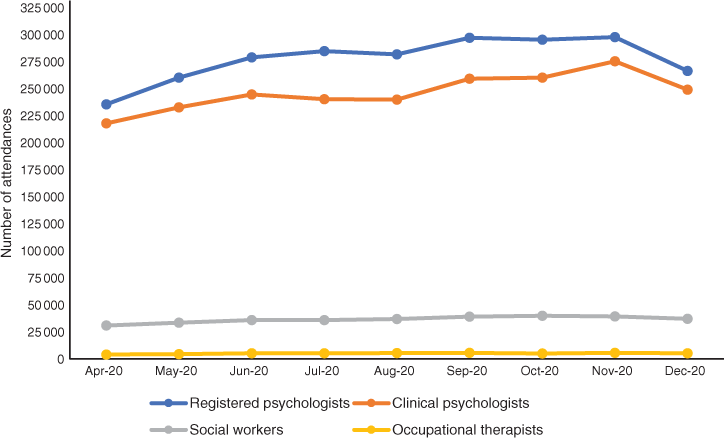
|
Trends in allied mental health and telehealth service delivery in Australia
Figure 2 illustrates the number of attendances per month in Australia, comparing the COVID-19 period with the 2019 baseline period. Figure 2 shows that fewer services were delivered during the early COVID-19 lockdown period in Australia (April–May 2020). This was followed by a rise in the number of attendances for the remainder of the year with a peak period in November. This finding is consistent with predictions that there would be increased demand for mental health interventions due to the pandemic. The decline during the December–Christmas period is consistent with annual patterns.8
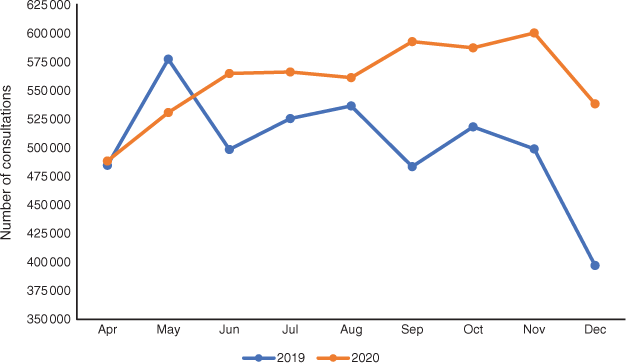
|
Telehealth use was substantial: April was the highest month of use when 53% of all services were delivered by either videoconference or telephone consultations (257 406/488 618). In terms of each 2020 quarter, Figure 3 shows telehealth sessions constituted 46% of all consultations for Quarter 2, 34% of Quarter 3, and 31% of Quarter 4 respectively. Figure 4 illustrates the overall increase in face-to-face consultations during 2020, especially as the first wave of the COVID-19 cases in Australia receded for most states and territories from May 2020. Videoconferencing peaked in May followed by a slow decline through June and July (when face-to-face sessions steeply increased). During August and September videoconferencing increases again, followed by a gradual decline from October to December. Telephone use was highest in April and steadily declined from May to December.
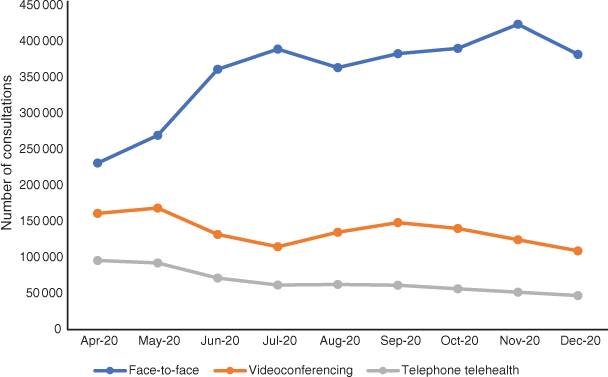
|
Victoria vs Australia
Australia experienced an initial wave of COVID-19 infections from April to June 2020 and sporadic outbreaks during the year. However, the state of Victoria experienced a second wave of deadly infections from July to October 2020,13 resulting in strict stay-at-home orders and restrictions on travel, social gatherings, and activities. Figure 5 illustrates the rate of allied mental health consultations per 100 000 for all states and territories of Australia during 2020. There is a trend for more services provided to Victoria compared with the rest of Australia, rising steeply during Victoria’s lockdown period from July to October 2020. Given that the larger states, such as Victoria, are higher users of the Better Access scheme, we also compared the trend during COVID-19 for Victoria with the baseline period. During the baseline period 2019, there were 1 352 721 allied mental health consultations compared with 1 559 870 in the same period 2020, representing an overall increase of 15% for Victoria. Figure 6 shows that during the first wave (Quarter 2 2020), there was less activity in Victoria, followed by a large increase in the number of consultations during 2020. This rise in consultations from August 2020 also corresponds with the increase in the number of AMHP sessions allowed under the scheme.
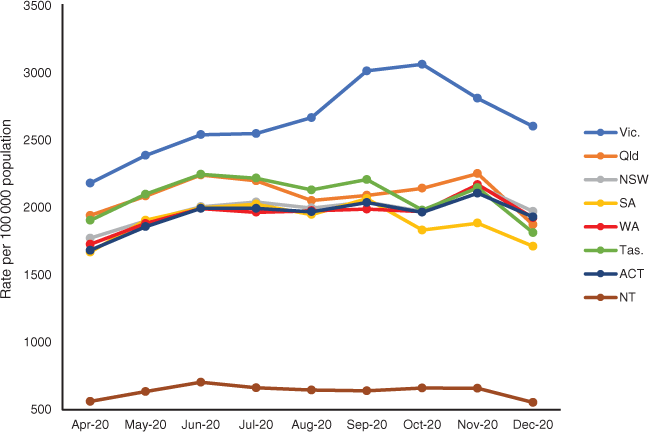
|
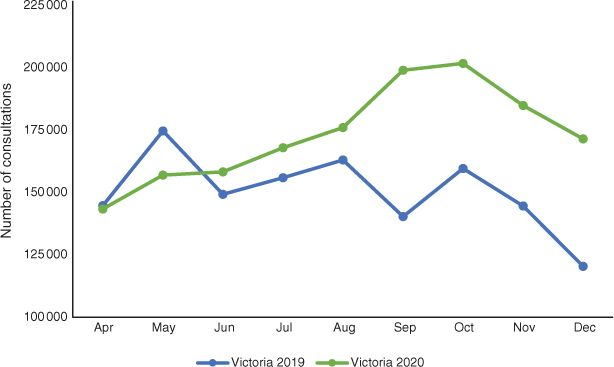
|
Discussion
Our analysis showed an overall 11% increase in the number of allied mental health services during the COVID-19 period (face-to-face and telehealth combined). During the first wave, private practitioners rapidly transitioned to delivering treatments using new MBS Better Access telehealth items, resulting in 53% of sessions delivered by telehealth in April 2020. In Quarter 2 2020, following the implementation of public health policies to ‘flatten the curve’ of the pandemic, 46% of allied mental health treatments were delivered by telehealth. This finding was very similar to the rate in the same quarter for private practice telepsychiatry (51%), although psychiatrists used telephone consultations more often that videoconferencing.14 Videoconferencing was the preferred mode of delivery by AMHPs. This may be due to patient or clinician preference, including the importance of attending to a patient’s visual cues or screen sharing of written materials when delivering psychological interventions. Following its rapid increase in use, telehealth steadily declined to less than a third of consultations by the end of 2020, which is still a significant proportion of health care delivery.
Prior to the pandemic, the uptake of telehealth in Australia was described as ‘slow and fragmented’.15 Telehealth by AMHPs represented less than 0.2% of all consultations during 2019. The Productivity Commission report on mental health has raised concerns about the existing scheme, including the underutilisation of telehealth sessions and poor access for those with moderate to severe mental illness.16 The report recommended improving access for those with higher intensity treatment needs, and increasing their number of subsidised sessions. Widening access to psychological therapy by videoconferencing was emphasised as a priority reform.
Recently, telehealth services performed by medical practitioners and a range of healthcare professionals were temporarily extended until the end of 2021.17 A recent report by Australia’s leading researchers from the Group of Eight universities recommended making telehealth permanent due to the significant predicted increase in mental health and substance abuse disorders in the aftermath of the pandemic.18 Peak bodies for psychiatry19 and psychology20 have also called for telehealth to remain beyond COVID-19, due to its acceptance, convenience, and effectiveness, which has improved access to care. Telehealth services are ideally suited to address the increased mental health needs during and beyond the pandemic.21 To effectively sustain it, five key requirements have been recommended: a) developing a skilled workforce, b) empowering patients, c) reforms to funding, d) improvements to digital systems, and e) integrating telehealth into routine care.22
Limitations of this study include reliance on administrative data that provides information on what was billed rather than the content and quality of the treatment that was delivered. The Medicare data give no information on the proportion who were new patients and those who were receiving ongoing care. We therefore cannot determine how many patients were new referrals as opposed to transfers from face-to-face to telehealth consultations mid-therapy.
Conclusions
Despite Australia’s relative success at suppressing the virus, and burgeoning vaccination (at the time of writing), the COVID-19 pandemic remains unpredictable. Telehealth provision with the Better Access scheme showed its potential to expand its capacity to respond to the mental health needs of those Australians who have been, and continue to be, adversely affected. The pandemic greatly accelerated the adoption of telehealth by clinicians under the scheme: telehealth was rarely used in the year prior (0.2%), rising to more than half of all sessions at the peak of the crisis. In the long-term, maintaining telehealth could extend the reach of mental health care during future pandemics, extreme weather events and global crises. It has the potential to reduce mental health care disparities by improving access for those who reside outside of well-serviced metropolitan areas. Future research should monitor changes in the uptake of allied mental health services and preparedness for the expected surge in demand for treatment.
Competing interests
Dr Reay works part-time in private practice and is a registered Medicare Provider with the Better Access scheme. Professor Looi works part-time in private practice as a registered Medicare and Department of Veterans’ Affairs provider of psychiatric consultations. Professor Kisely declares no competing interests.
Declaration of funding
This research did not receive any specific funding.
References
[1] Dawel A, Shou Y, Smithson M, Cherbuin N, Banfield M, Calear AL, et al The effect of COVID-19 on mental health and wellbeing in a representative sample of Australian adults. Front Psychiatry 2020; 11 579985| The effect of COVID-19 on mental health and wellbeing in a representative sample of Australian adults.Crossref | GoogleScholarGoogle Scholar | 33132940PubMed |
[2] Newby JM, O’Moore K, Tang S, Christensen H, Faasse K. Acute mental health responses during the COVID-19 pandemic in Australia. PLoS One 2020; 15 e0236562
| Acute mental health responses during the COVID-19 pandemic in Australia.Crossref | GoogleScholarGoogle Scholar | 32722711PubMed |
[3] World Health Organization (WHO). Substantial investment needed to avert mental health crisis. 14 May 2020. Available at https://www.who.int/news/item/14-05-2020-substantial-investment-needed-to-avert-mental-health-crisis [accessed 19 January 2021].
[4] Australian Government Department of Health. Australians embrace telehealth to save lives during COVID-19. 20 April 2020. Available at https://www.health.gov.au/ministers/the-hon-greg-hunt-mp/media/australians-embrace-telehealth-to-save-lives-during-covid-19 [accessed 13 October 2020].
[5] Australian Government Department of Health. Fact sheet for allied health professionals: Better Access to Psychiatrists, Psychologists and General Practitioners through the MBS (Better Access) initiative. 2019. Available at https://www.health.gov.au/resources/publications/better-access-fact-sheet-professionals [accessed 20 August 2020].
[6] Australian Government Department of Health. Factsheet for additional 10 MBS mental health sessions. 2020. Available at http://www.mbsonline.gov.au/internet/mbsonline/publishing.nsf/Content/Factsheet-10MentalHealthSessions [accessed 21 October 2020].
[7] Australian Government Department of Health. Modified Monash Model. 2020. Available at https://www.health.gov.au/health-workforce/health-workforce-classifications/modified-monash-model [accessed 20 October 2020].
[8] Australian Institute of Health and Welfare (AIHW). Mental health impact of COVID-19. 30 March 2021. Available at https://www.aihw.gov.au/reports/mental-health-services/mental-health-services-in-australia/report-contents/covid-19-impact-on-mental-health#mental-health [accessed 3 February 2021].
[9] Jayawardana D, Gannon B. Use of telehealth mental health services during the COVID-19 pandemic. Aust Health Rev 2021; 45 442–6.
| Use of telehealth mental health services during the COVID-19 pandemic.Crossref | GoogleScholarGoogle Scholar | 33583488PubMed |
[10] Reay RE, Keightley P, Looi JCL. Telehealth mental health services during COVID-19: summary of evidence and clinical practice. Australas Psychiatry 2020; 28 514–6.
| Telehealth mental health services during COVID-19: summary of evidence and clinical practice.Crossref | GoogleScholarGoogle Scholar | 32722963PubMed |
[11] Snoswell CL, Caffery LJ, Haydon HM, Thomas EE, Smith AC. Telehealth uptake in general practice as a result of the coronavirus (COVID-19) pandemic. Aust Health Rev 2020; 44 737–40.
| Telehealth uptake in general practice as a result of the coronavirus (COVID-19) pandemic.Crossref | GoogleScholarGoogle Scholar | 32853536PubMed |
[12] Looi JCL, Allison S, Bastiampillai T, Pring WJ. Private practice metropolitan telepsychiatry in larger Australian states during the COVID-19 pandemic: an analysis of the first 2 months of new MBS telehealth item psychiatrist services. Australas Psychiatry 2020; 28 644–8.
| Private practice metropolitan telepsychiatry in larger Australian states during the COVID-19 pandemic: an analysis of the first 2 months of new MBS telehealth item psychiatrist services.Crossref | GoogleScholarGoogle Scholar |
[13] Victoria State Government Department of Health and Human Services. Victorian coronavirus (COVID-19) data: daily new cases in Victoria. 2021. Available at https://www.coronavirus.vic.gov.au/victorian-coronavirus-covid-19-data [accessed 8 June 2021].
[14] Looi JCL, Allison S, Bastiampillai T, Pring W, Reay R. Australian private practice metropolitan telepsychiatry during the COVID-19 pandemic: analysis of Quarter-2, 2020 usage of new MBS-telehealth item psychiatrist services. Australas Psychiatry 2021; 29 183–8.
| Australian private practice metropolitan telepsychiatry during the COVID-19 pandemic: analysis of Quarter-2, 2020 usage of new MBS-telehealth item psychiatrist services.Crossref | GoogleScholarGoogle Scholar |
[15] Smith AC, Thomas E, Snoswell CL, Haydon H, Mehrotra A, Clemensen J, Caffery LJ. Telehealth for global emergencies: implications for coronavirus disease 2019 (COVID-19). J Telemed Telecare 2020; 26 309–13.
| Telehealth for global emergencies: implications for coronavirus disease 2019 (COVID-19).Crossref | GoogleScholarGoogle Scholar | 32196391PubMed |
[16] Australian Government Productivity Commission. Final report of the Productivity Commission on mental health. 2020. Available at https://www.pc.gov.au/inquiries/completed/mental-health#report [accessed 24 November 2020].
[17] Australian Government Department of Health. Providing health care remotely during COVID-19. 2021. Available at https://www.health.gov.au/news/health-alerts/novel-coronavirus-2019-ncov-health-alert/coronavirus-covid-19-advice-for-the-health-and-disability-sector/providing-health-care-remotely-during-covid-19 [accessed 4 May 2021].
[18] Group of Eight Australia. COVID-19 road map to recovery: a report for the nation. 2021. Available at https://go8.edu.au/wp-content/uploads/2020/05/Go8-Road-to-Recovery.pdf [accessed 27 March 2021].
[19] The Royal Australian and New Zealand College of Psychiatrists. Call for ongoing telehealth to complement face-to-face consultations. 29 June 2020. Available at https://www.ranzcp.org/news-policy/news-archive/news-archive-2020/call-for-ongoing-telehealth-to-complement-face-to [accessed 29 March 2021].
[20] Australian Psychological Society. Psychologists welcome telehealth extension. 14 March 2021. Available at https://www.psychology.org.au/About-Us/news-and-media/Media-releases/2021/Psychologists-welcome-telehealth-extension [accessed 29 March 2021].
[21] Zhou X, Snoswell CL, Harding LE, Bambling M, Edirippulige S, Bai X, Smith AC. The role of telehealth in reducing the mental health burden from COVID-19. Telemed J E Health 2020; 26 377–9.
| The role of telehealth in reducing the mental health burden from COVID-19.Crossref | GoogleScholarGoogle Scholar | 32202977PubMed |
[22] Thomas EE, Haydon HM, Mehrotra A, Caffery LJ, Snoswell CL, Banbury A, Smith AC. Building on the momentum: sustaining telehealth beyond COVID-19. J Telemed Telecare 2020;
| Building on the momentum: sustaining telehealth beyond COVID-19.Crossref | GoogleScholarGoogle Scholar | 32985380PubMed |
Appendix 1. AMHPs MBS-item numbers included in analysis

|


